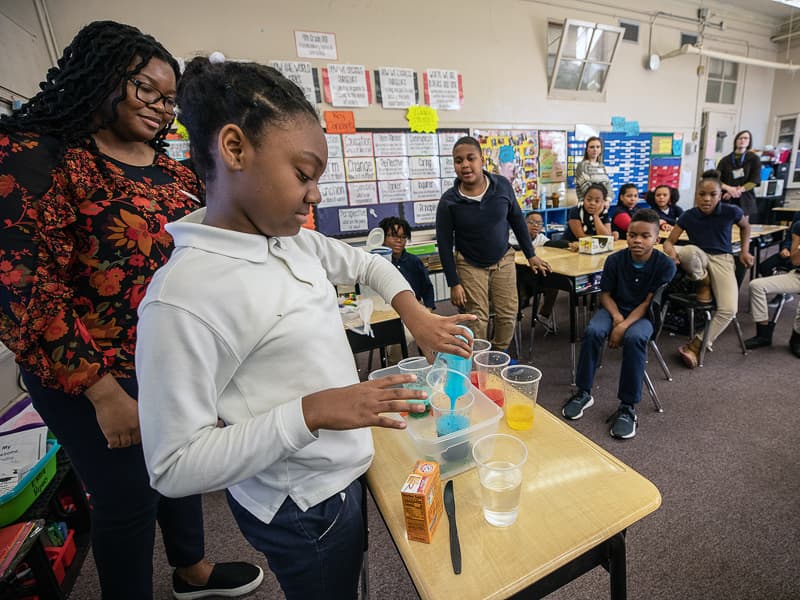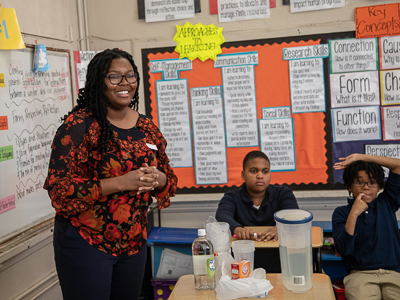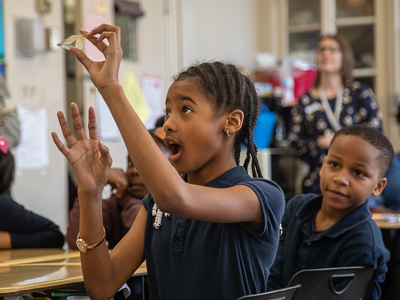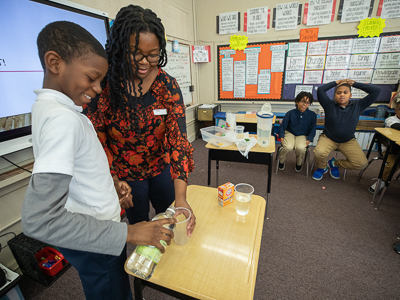SGSHS REACHes elementary students for science education

There are few classroom demonstrations as joy-inducing as the vinegar-and-baking soda volcano. How much more fun is it to make six of them in rainbow colors?
It’s more than fun: it’s a lesson on the properties of light through Project REACH, or Reaching Education and Changing Healthcare, a partnership between the University of Mississippi Medical Center and Barack H. Obama Magnet Elementary School in Jackson. Students and postdoctoral fellows from the School of Graduate Studies in the Health Sciences lead monthly lessons designed to reinforce and enhance the science concepts the younger students learn in their classes.

“[Obama Elementary Project REACH coordinator] Beth West Roach provides us with learning objectives and outcomes in a schedule each year, and the graduate students have freedom to create a lesson plan that helps meet those outcomes,” said Dr. Hanna Broome, SGSHS assistant dean of graduate education and Project REACH coordinator.
On March 5, Obama Elementary fourth-graders had a lesson on light from “Miss Daisy the Science Lady.” That’s the alter ego of Adesuwa Ekunwe, a master’s of science in biomedical sciences student from Clinton.
“Who can tell me about Isaac Newton?” Ekunwe asked the fourth-graders. Most of the students raised their hands.
“He came up with the three rules of gravity!” one said.
“He learned about light and colors!” another added.

Meanwhile, students passes around a prism, like the one Newton used to develop his theory of color, to create rainbows using the light shining through their classroom window.
Fourth-grade teacher Jennifer Tanner said her students look forward to Project REACH because of the hands-on activities.
“The lessons relate to what they’ve learned in class, but they gain a deeper knowledge of the topic,” Tanner said. “I love the reaction on the [visiting graduate] students’ faces when they ask a question they don’t think my students will know the answer to, and then they get it right.”
The students continued to answer Ekunwe’s questions about reflection, absorption, and refraction with ease.
“Refraction is when something becomes bent,” one student said.
Their demeanors went from confident to ecstatic when Ekunwe brought out the volcano supplies. The students took turns adding the red, orange, yellow, green, blue, and violet food dyes, creating the bubbly oozes, and finally mixing them all together to make black.

Project REACH is one way for SGSHS students and trainees to experience education from the other side of the desk. In creating lesson plans, delivering said lesson and engaging students with the material, they advance their professional development by learning skills applicable to multiple health sciences career opportunities.
“I think each student should have to teach, because the experience usually gives them a greater appreciation for those teachers and faculty who have taught them and the profession as a whole. We get overwhelmingly positive feedback from our students and trainees that participate in Project REACH each year” Broome said.
Project REACH also introduces the younger students to health science-related educational and career opportunities. Some are already making plans: one fourth-grader wants to be a veterinarian, another a scientist.
And when Ekunwe told the students she plans to go to medical school and become a doctor, the whole class cheered.


